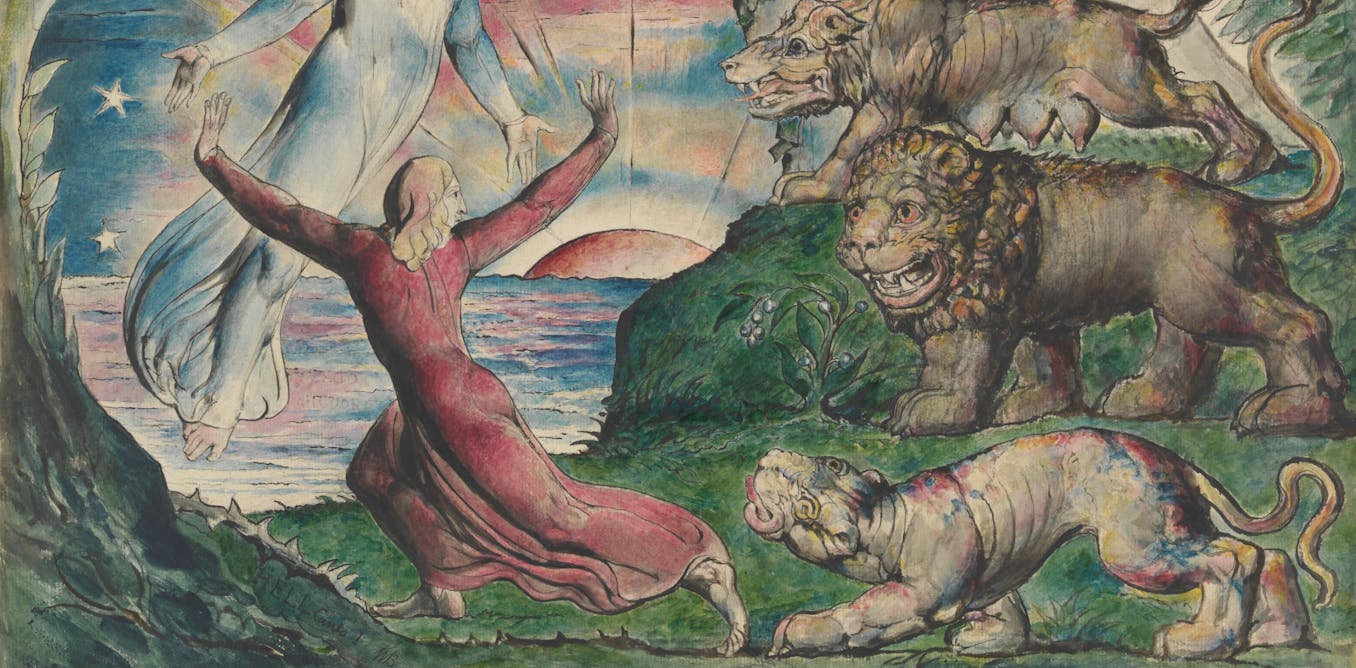Schiaparelli couture show featured animal heads inspired by Dante’s Inferno – here’s what they mean
The spectacle of the spring/summer 2023 Schiaparelli couture show began before a single model set foot on the runway.
Media personality Kylie Jenner arrived wearing a lifelike faux taxidermy lion on her shoulder and rapper Doja Cat came as a bedazzled devil, painted head to toe in red and studded with 30,000 crystals.
Both costumes were a nod to the inspiration behind creative director Daniel Roseberry’s show – Dante’s Divine Comedy (1320).
In Roseberry’s show notes, he described the collection as an “homage to doubt”.
I wanted to step away from techniques I was comfortable with and understood, to choose instead that dark wood where everything is scary but new … Inferno, Purgatorio, Paradiso: One cannot exist without the others … It is a reminder that there is no such thing as heaven without hell; there is no joy without sorrow; there is no ecstasy of creation without the torture of doubt.
Into the woods
The “dark wood” Roseberry speaks of is the setting for the first canto of Inferno, where pilgrim Dante can be found, having lost his way on the path towards truth. Dante looks up to see a high mountain bathed in sunlight and it gives him hope.
As he attempts to climb the holy mountain, Dante encounters three beasts – a leopard, a lion and a she-wolf. He is forced back down into the dark woods by the she-wolf, where he is visited by the Roman poet Virgil, who acts as his spiritual guide into the inferno (hell).
The beasts of the Schiaparelli show appear in the same order. A strapless faux fur dress with the roaring head of a snow leopard was the tenth item on show, followed by the lion dress seen on Kylie Jenner (look 15) and finally Naomi Campbell wearing a black shaggy jacket with a she-wolf’s head peeping out of the shoulder (look 30).
Beastly meanings
Canto I, in which these beasts appear, is one of the most discussed by scholars and there are multiple interpretations of the animals and their meaning. Most scholars agree that the animals are allegorical – representations of the sins of man that stop him reaching the truth of God. However, the specific sins they represent are debated.
One view holds the leopard represents lust, the lion, pride and the she-wolf greed.
In Dante’s day, leopards were often incorporated into coats of arms for children of adultery, as the animal was associated with heat and desire. Evidence of the lion symbolising pride can be found in the Inferno, as it is described as having its “head held high”. Meanwhile the she-wolf is described as “laden in her meagreness”, “with all her hungerings”, representing greed.
Other scholars have argued that the beasts represent all of humanity’s sins. The circles of the Inferno are divided into three sections. The uppermost are the sins of “incontinence” (inability to control desires), in the middle there are sins of violence and in the lowest circles of hell are sins of fraud.
In his Introduction to the Divine Comedy (1910), critic Francesco Flamini argues that the three beasts represent the three categories of sin in Dante’s Inferno – the leopard is fraud, the lion, violence and the wolf “incontinence”. Some critics invert this and see the leopard as incontinence and the she-wolf as fraud, as this would mirror the order in which the reader encounters these sins in the poem.
Writer and translator Aldo Benardo proposed an argument supporting Flamini’s order (leopard as fraud, lion as violence, she-wolf as incontinence). He suggests that we imagine Dante’s perspective as similar to Satan’s – one of looking up through the circles of hell towards the heavens. From Satan’s point of view, he sees fraud first, then violence and finally incontinence.
Unlike Satan, Dante can see beyond up to the light on the top of the mountain and the celestial objects. Benardo argues that Dante presents us with a view of creation “from bottom to top”.
Medievalist John G. Demaray argues that there is also a literal interpretation of the three beasts. The shore, desert and mountains of the Inferno recall the shores, deserts and mountains of the Biblical Exodus route for pilgrims during Dante’s time, where it was common for travellers to encounter such beasts.
Perhaps the leopard, lion and she-wolf can be read as representing both the physical and spiritual threats that pilgrims were likely to encounter on their travels from Egypt to Mount Sinai.
What does this mean for Schiaparelli?
This brings us back to the Schiaparelli show. Speaking of the inspiration he found in Dante, Roseberry notes: “No ascension to heaven is possible without first a trip to the fires, and the fear that comes with it.”
The literal rendering of Dante’s beasts in Schiaparelli’s spring/summer show serve as reminders of this creative journey.
With Dante’s allegory in mind, perhaps the celebrities wearing Schiaparelli’s beast heads could be seen to represent the spiritual threats that stand between the modern day “everyman” (formerly Dante’s pilgrim) and peace. Maybe celebrities themselves have become the new beasts, representing as they do great material wealth, desire and the fraud of online influencing.
